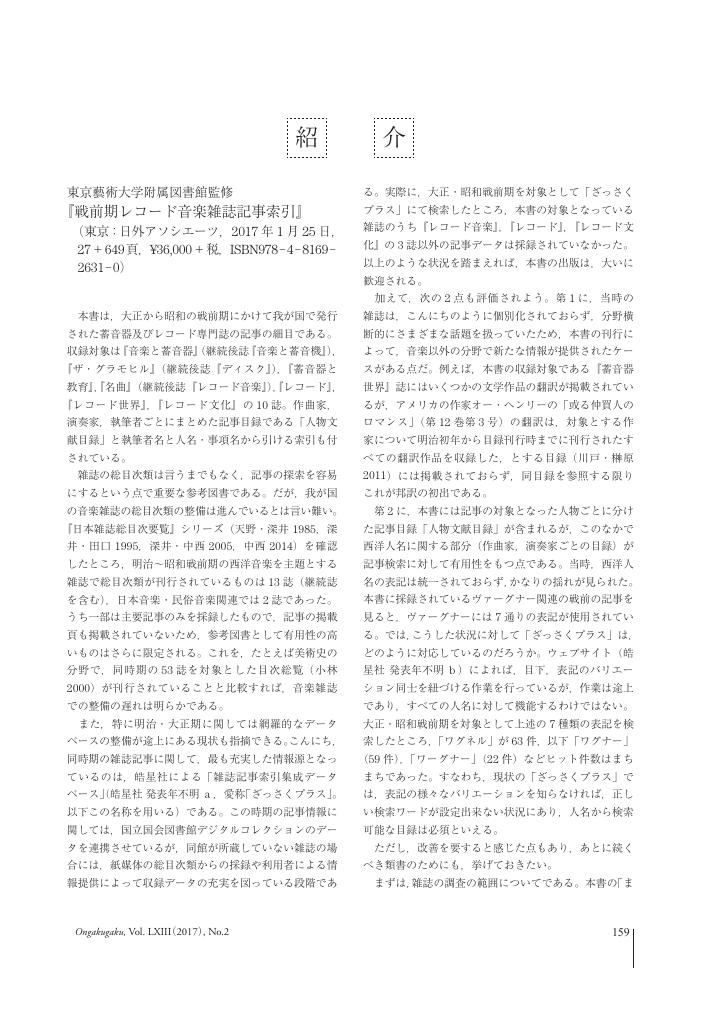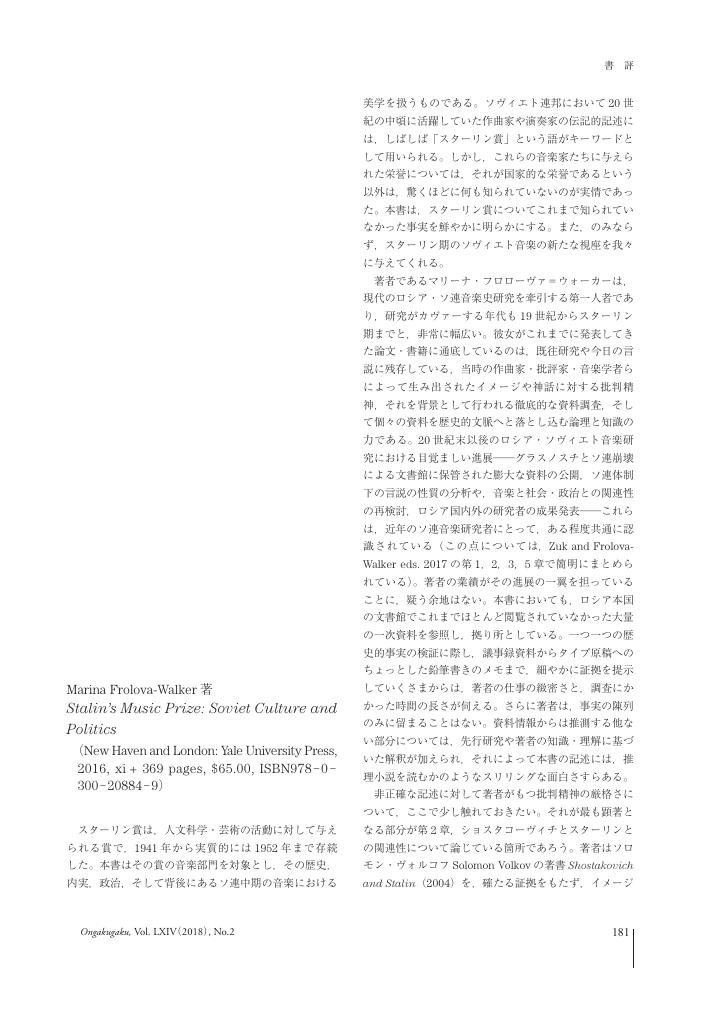- 著者
- 西澤 忠志
- 出版者
- 日本音楽学会
- 雑誌
- 音楽学 (ISSN:00302597)
- 巻号頁・発行日
- vol.68, no.1, pp.32-48, 2022 (Released:2023-10-15)
日本において西洋音楽は、明治時代(1868-1912)から本格的に受容され始めた。当初、教育やナショナリズムの涵養に資するものと見なされた西洋音楽は、明治20 年後半から学生や学者といった知識人によって「芸術」と見なされた。その中でも、文芸評論家として知られる上田敏は、学生時代に日本で初めて演奏批評を文芸雑誌に掲載した。 本論文は、日本において西洋音楽が芸術として評価された過程と、その思想的・社会的背景を、上田敏が演奏批評で使用した評価基準である「エキスプレッション」の意味を分析することで明らかにする。 まず、本論文は上田が演奏批評で使用した「エキスプレッション」の意味について検討する。「エキスプレッション」の重要性は、既に上田が演奏批評を発表する前に、精神や感情を表現する語として、洋書を通じて日本の音楽界に紹介されていた。上田はこれを、初めて演奏の評価基準として使用した。次に本論文は、上田が「エキスプレッション」を演奏批評で使用した思想的・社会的背景を検討する。上田は、音楽において具現化された精神と感情を強調した、ショーペンハウアーに代表される19世紀のヨーロッパにおける芸術観を特に高く評価した。彼はまた音楽を、主に女性と子供のための娯楽と見なす既存の音楽観とは異なる、「青年」層の情熱を表現する芸術であることを示そうとした。 以上の特徴を持つ上田の演奏批評は、限定されていた日本の音楽観に対して新たな視点を示すこととなった。そして、彼の音楽批評は、日本における洗練された文化としての西洋音楽の普及を助けることとなった。
2 0 0 0 OA 法隆寺と正倉院の尺八の音律
- 著者
- 明土 真也
- 出版者
- 日本音楽学会
- 雑誌
- 音楽学 (ISSN:00302597)
- 巻号頁・発行日
- vol.59, no.1, pp.1-15, 2013-10-15 (Released:2017-04-03)
This article investigates in detail the pipe lengths and the temperaments of the shakuhachi preserved at the Horyu-ji Temple, as well as those of the eight specimens owned by the Shoso-in Repository, in order to examine their provenance, including the countries of origin. It has thus far widely been understood that the shakuhachi was invented by LU Cai (呂才: circa 600-665) of the Tang (唐) Dynasty. Therefore, the measurement of the instruments of both the Horyu-ji Temple and the Shoso-in was long considered to have been based on Tang-xiao-chi (唐小尺) measurement, even though some of them at the Shoso-in do not match it. Given such discrepancies, I propose, based on the Old Book of Tang (945) and the New Book of Tang (1060), as well as the residual sum of squares of the distinct temperaments, to classify shakuhachi instruments into categories: pre-LU and post-LU. Through this classification it becomes clear that the pre-LU pipes are one chi (尺) and eight cun (寸) long and are unstable in temperaments, while the post-LU ones can vary in length according to the ancient Chinese pitch pipes (twelve size in total) and are stable in temperaments in accordance with the method of sanfen-sunyi (三分損益, a kind of the circle-of-fifths system). This finding also indicates that the shakuhachi preserved at the Horyu-ji Temple was a pre-LU one, whereas the ones at the Shoso-in conformed to post-LU. In addition, I argue, based on my close study of the Book of Sui (656) and of the 95 % confidence interval of the residual error for the theoretical values of the pipe lengths, that it is reasonable to classify the pipe length of the specimens both at the Horyu-ji Temple and the Shoso-in into two measurements, that is, those based on the Tang-xiao-chi and those based on the Wei-chi (魏尺). Since the four shakuhachi instruments given by Uija-wang (義慈王, Uija of Baekje, 599-660) have pipe length in accordance with the Wei-chi, we can say with fair certainty that the Wei-chi was used in Baekje (百済).
- 著者
- 金光 真理子
- 出版者
- 日本音楽学会
- 雑誌
- 音楽学 (ISSN:00302597)
- 巻号頁・発行日
- vol.67, no.1, pp.17-33, 2021 (Released:2022-10-15)
本稿は、イタリアの民俗舞踊「タランテッラ」、とくにルカーニア地方の「パストラーレ」を対象とし、パストラーレ特有のリズム感とそれを演奏する/踊る身体技法の関係を明らかにし、音楽と舞踊に共通する身体性を論じた。パストラーレの演奏にはイタリアのバグパイプであるザンポーニャが不可欠であることから、その楽器構造と音楽構造を整理した上で、ザンポーニャ奏者の身体動作と音楽のリズムの関係を考察した。その結果、ザンポーニャ奏者はチャンター管の指孔を「閉じる→開く」動作によってパストラーレの3分割リズム(♩ ♪)を演奏しているが、1)その身体感覚は指孔を「閉じる」一つの動作にあること、2)「閉じる」動作を強く長くすることで、ドローン音の効果が伴われ、強拍すなわち舞踊のビートを強調できること、3)「閉じる」動作のコントロールによって、3分割リズムと2分割リズムのあいだで自由に演奏できることが分かった。さらに、ステップの考察を通して、踊り手は「右足→左足」のステップで3分割リズムを踏んでいるが、1)その身体感覚は重心のかかった「右足」を踏み込む一つの動作にあること、2)「右足」を強く長く踏み込むことで強拍すなわち舞踊のビートを強調していること、3)「右足」を踏み込む長さと重さのコントロールによってステップを3分割リズムから2分割へ変えられることが分かった。結論として、1)これまでタランテッラの3分割リズムと2分割リズムの関係は「曖昧なリズム」と論じられてきたが、むしろ「交換可能で流動的なリズム」と新たに解釈できることを示し、2)ザンポーニャ奏者と踊り手の身体感覚が一致することによって、タランテッラのリズムが音楽と舞踊に分かち持たれていることを指摘した。
- 著者
- 宮川 渉
- 出版者
- 日本音楽学会
- 雑誌
- 音楽学 (ISSN:00302597)
- 巻号頁・発行日
- vol.65, no.2, pp.90-105, 2020 (Released:2021-03-15)
本稿の目的は,カイヤ・サーリアホが,《光の弧》において,フランス国立音響音楽研究所(IRCAM)で開発されたコンピュータ技術を用いていかにスペクトル音楽の作曲技法を実践したかを検証することである。そのため,まずスペクトル音楽の作曲技法の中核をなすものが「モデル」と「変形プロセス」という2つの考えに基づいていることを確認し,次にこれらの2点が《光の弧》においていかに現れているかを検証した。具体的には,サーリアホが残したコンピュータ・プログラムのデータ,スケッチなどの分析を中心に調査を進めた。 その結果,「モデル」という考えは,IANAというコンピュータ・プログラムを用いてチェロの音をスペクトル解析した結果を和音として使用するサーリアホの手法の中に見出すことができ,また「変形プロセス」に関しては,Formesというコンピュータ・プログラムが算出した「補間法」を用いてリズムを構築する方法において見られた。しかし,サーリアホはコンピュータが算出するデータをそのままの形で使用したのではなく,それらを変形させたり,一部のみを取り上げたりすることによって,作曲に必要な音素材に変えていった。このように《光の弧》の作曲過程において,彼女はスペクトル音楽の作曲技法を厳格にではなく,より自由な形で扱っていることが判明した。
- 著者
- 松本 直美
- 出版者
- 日本音楽学会
- 雑誌
- 音楽学 (ISSN:00302597)
- 巻号頁・発行日
- vol.57, no.1, pp.56-68, 2011-10-05
The contribution of Marquis Pio Enea degli Obizzi (1592-1674) to the early history of opera was noted first by the 17th-century chronicler Cristoforo Ivanovich. He indicated in his (in) famous Le memorie teatrali di Venezia (first published in 1681) that L'Ermiona, an 'opera torneo' (opera tournament) performed in Padua in 1636, for which the Marquis contributed to the libretto, had been nothing less than the direct impetus for the inauguration of the first-ever commercial opera house in Venice in the following year. This paper will first introduce Obizzi, whose activities have been under-investigated in previous scholarship. Then, it will explore the opera tournaments with which the Marquis was involved during the 1630s and 40s. The paper will argue that this genre did indeed (as Ivanovich implies) directly influence the formation of commercial opera in Venice. Moreover, drawing on little-known sources, Obizzi's vital role - as a plot deviser - in those productions will be indicated and the significant implications concerning this function in our notion of 'authorship' in the early operatic production will be explored. Finally, it will be proposed that a detailed analysis of Obizzi's works not only enables us to trace the crucial transition which opera of that time took - from court to commercial enterprise - but also suggests new perspectives in relation to our understanding of early opera industry as a whole.
- 著者
- 曹 有敬
- 出版者
- 日本音楽学会
- 雑誌
- 音楽学 (ISSN:00302597)
- 巻号頁・発行日
- vol.66, no.1, pp.1-15, 2020 (Released:2021-10-15)
本稿は、音楽におけるコラージュの諸相を、1970年代のマーラー解釈という側面からあぶり出し、アカデミックな領域と音楽実践領域の両者において音楽のコラージュがどのように理解されていたのかを検討するものである。 音楽のコラージュは20世紀後半以降の現代音楽における重要な作曲技法の一つであるが、従来の研究では、借用技法の下位概念として取り扱われ、その技法的側面のみが注目されてきた。それは、間テクスト性や記号論などといった有意義な分析方法を提示したものの、その文化・歴史的視点は見落とされている。本稿では、上記の方法論の問題を念頭におきながら、これまで音楽技法を理解するための2次文献と扱われてきた言説史料を、当時の思想を表す1次文献として取り扱い、1970年代の音楽におけるコラージュ理解・受容のあり方を解明する。 1970年代の音楽学者W・デームリング 、T・クナイフ 、そして同時代の作曲家G・リゲティ のマーラー論を取り上げ、「コラージュ」という言葉の用例を分析した結果、当時音楽のコラージュが形式論や意味論、音楽の社会的機能といった異なる視点から多義的に論じられていたことを明らかにした。また、そのような様々な視点の背景として次の2点が解き明かされた。1)当時、コラージュの理論化を目指した他の研究と同様に、彼らのコラージュへの理解も、造形芸術における様々なコラージュ論を前提にしていること、2)音楽学の領域では、コラージュを音楽の内部構造分析または音響認識の側面に焦点が当てられた一方、音楽的実践を行なった作曲家の立場では、当時彼らを囲んでいた社会的、文化的状況から得た知見がコラージュに組み込まれていたことである。本稿は、このような背景を明らかにすることで、音楽のコラージュの初期受容への理解に新たな洞察ばかりでなく、1970年代のコラージュ実践の文化的意味に関する今後の研究のための素地も提供する。
- 著者
- 西田 紘子
- 出版者
- 日本音楽学会
- 雑誌
- 音楽学 (ISSN:00302597)
- 巻号頁・発行日
- vol.65, no.1, pp.1-17, 2019 (Released:2020-10-15)
1980年代以降、米国では、D. ルーウィンの『一般化された音程と変形』(1987)で提唱された変形理論から発展して、H. クランペンハウアーやB. ハイアー、R. コーンによる一連の論考を中心にネオ・リーマン理論が形作られてきた。この理論は、ポスト調性音楽や後期ロマン主義音楽を分析対象として展開されてきたが、2000年代に入ると音楽理論史的な問い直しも現れ始めた。すなわち、ネオ・リーマン理論の論者たちが、ドイツの音楽理論家フーゴー・リーマンによる諸概念をどのように領有したか、それが主要な論点の一つである。 その代表的論考(Engebretsen 2011)によれば、和声進行に関する「進行/転換 Schritt/Wechsel」というリーマンの概念と分類学(Riemann 1880)は、ネオ・リーマン理論において「同主調」「導音転換」「平行調」(すなわちPLR)の変形群へと置き換えられたものの、両者には和音近親や調性の捉え方等の違いがあるという。その点で、ネオ・リーマン理論はリーマン理論を再発見しただけでなくその趣旨を更新したと言われる。 こうした主張は一定の妥当性を有する一方、以下の3点から、通史的に再考されなくてはならない。(1)リーマンの概念とその元となったA. エッティンゲンの概念(1866)との関係や、リーマンの理論的思考の心理学的転回を含めたリーマンの和声理論の動態、(2)ネオ・リーマン理論の各論者によるPLR以外も含む変形諸概念との関係、(3)2000年代以降のネオ・リーマン理論第2世代(Kopp 2002, Rings 2011)におけるPLR変形の変容およびそれとリーマンの諸概念との関係、である。本稿ではこれらの点から、より広範で緻密な言説分析の基に先行研究による歴史化を更新し、リーマンに由来する諸概念の変容の過程を、領有と歴史化の相互作用および方法の洗練過程として示した。
2 0 0 0 OA グィド・アドラーの音楽学体系における音楽美学――心理学との関係と「内容分析」の射程――
- 著者
- 小川 将也
- 出版者
- 日本音楽学会
- 雑誌
- 音楽学 (ISSN:00302597)
- 巻号頁・発行日
- vol.65, no.2, pp.106-121, 2020 (Released:2021-03-15)
本稿は、グィド・アドラーの著作『音楽史の方法』(1919年、以下『方法』)を主たる対象に、彼の音楽学体系内にその座を与えられる「音楽美学」とは〈心理学的美学〉であることを示すとともに、音楽様式の「内容分析(Inhaltsanalyse)」と〈心理学的美学〉との接点を、特にオーストリア哲学の文脈から読み取る試みである。 従来のアドラー研究は、彼の美学批判に繰り返し注目してきた。たしかに、論文「音楽学の範囲、方法、目的」(1885年、以下「体系論文」)や『方法』内には、美学理論が思弁的であり厳密な根拠に欠ける点を批判する記述がある。しかし、両著作中に掲載された音楽学体系図には、音楽学の体系的部門の一分野として「音楽美学」が記されていることも事実であり、アドラーの美学に対する消極的姿勢を強調するのは一面的であるように思われる。本稿では、これまで個別に論じられてきた、美学、心理学そしてオーストリア哲学に対するアドラーの見解を引用テクストと照合しながら総合的に検討し、「内容分析」をこれらの結節点として捉える。 はじめに、アドラーによる美学批判を確認したのち、彼が体系内に認める「音楽美学」とは〈心理学的美学〉を指していることを明らかにする(第1節)。続いて、「内容分析」に関連して、クレッチュマーの音楽解釈学、ディルタイの解釈学、そしてリップスの感情移入理論に対するアドラーの見解を分析する(第2節)。最後に「内容分析」と〈心理学的美学〉との接点を、ブレンターノ学派に属するクライビヒの論文「芸術創造の心理学への寄与」(1909)を手掛かりに考察する(第3節)。以上の考察を通じて、アドラー思想と心理学説との布置連関の一端が明らかになるとともに、歴史的心理学と記述的心理学との潜在的対立が彼のテクスト内に見出される。
2 0 0 0 OA 紹介:東京藝術大学附属図書館監修 『戦前期レコード音楽雑誌記事索引』
- 著者
- 松村 洋一郎
- 出版者
- 日本音楽学会
- 雑誌
- 音楽学 (ISSN:00302597)
- 巻号頁・発行日
- vol.63, no.2, pp.159-160, 2018 (Released:2019-03-15)
2 0 0 0 江戸期舞楽における動作様式の変遷--左方舞の下肢動作に着目して
- 著者
- 田鍬 智志
- 出版者
- 日本音楽学会
- 雑誌
- 音楽学 (ISSN:00302597)
- 巻号頁・発行日
- vol.49, no.3, pp.141-154, 2004-06
- 著者
- 山本 明尚
- 出版者
- 日本音楽学会
- 雑誌
- 音楽学 (ISSN:00302597)
- 巻号頁・発行日
- vol.64, no.2, pp.181-183, 2018 (Released:2020-03-15)
2 0 0 0 OA 法隆寺と正倉院の尺八の音律
- 著者
- 明土 真也
- 出版者
- 日本音楽学会
- 雑誌
- 音楽学 (ISSN:00302597)
- 巻号頁・発行日
- vol.59, no.1, pp.1-15, 2013-10-15
This article investigates in detail the pipe lengths and the temperaments of the shakuhachi preserved at the Horyu-ji Temple, as well as those of the eight specimens owned by the Shoso-in Repository, in order to examine their provenance, including the countries of origin. It has thus far widely been understood that the shakuhachi was invented by LU Cai (呂才: circa 600-665) of the Tang (唐) Dynasty. Therefore, the measurement of the instruments of both the Horyu-ji Temple and the Shoso-in was long considered to have been based on Tang-xiao-chi (唐小尺) measurement, even though some of them at the Shoso-in do not match it. Given such discrepancies, I propose, based on the Old Book of Tang (945) and the New Book of Tang (1060), as well as the residual sum of squares of the distinct temperaments, to classify shakuhachi instruments into categories: pre-LU and post-LU. Through this classification it becomes clear that the pre-LU pipes are one chi (尺) and eight cun (寸) long and are unstable in temperaments, while the post-LU ones can vary in length according to the ancient Chinese pitch pipes (twelve size in total) and are stable in temperaments in accordance with the method of sanfen-sunyi (三分損益, a kind of the circle-of-fifths system). This finding also indicates that the shakuhachi preserved at the Horyu-ji Temple was a pre-LU one, whereas the ones at the Shoso-in conformed to post-LU. In addition, I argue, based on my close study of the Book of Sui (656) and of the 95 % confidence interval of the residual error for the theoretical values of the pipe lengths, that it is reasonable to classify the pipe length of the specimens both at the Horyu-ji Temple and the Shoso-in into two measurements, that is, those based on the Tang-xiao-chi and those based on the Wei-chi (魏尺). Since the four shakuhachi instruments given by Uija-wang (義慈王, Uija of Baekje, 599-660) have pipe length in accordance with the Wei-chi, we can say with fair certainty that the Wei-chi was used in Baekje (百済).
2 0 0 0 紹介:寺内直子編著 『伶倫楽遊──芝祐靖と雅楽の現代』 (東京:アルテスパブリッシング,2017年12月25日,263+ⅸ頁,¥2,200+税,ISBN978-4-86559-173-6)
- 著者
- 塚原 康子
- 出版者
- 日本音楽学会
- 雑誌
- 音楽学 (ISSN:00302597)
- 巻号頁・発行日
- vol.64, no.2, pp.193-194, 2018
- 著者
- 井口 淳子
- 出版者
- 日本音楽学会
- 雑誌
- 音楽学 (ISSN:00302597)
- 巻号頁・発行日
- vol.62, no.2, pp.73-85, 2017
A. ストローク(Awsay Strok)とは、1910年代から日本敗戦後にいたるまで、およそ30年にわたり上海に居住し、ヨーロッパ、ロシア、米国から演奏家、歌手、オペラ団、バレエダンサーなどを招聘し、日本公演を含む「アジアツアー」をプロデュースしたユダヤ人興行主である(1876年2月27日、ラトヴィア、ドヴィンスク Dvinsk 生、1956年7月2日、東京没)。<br> 「A. ストローク」の名は、演奏家の評伝や東アジアの洋楽受容に関する文献のなかに「impresario、インプレサリオ、興行主、ディレクター、マネージャー」として数多く見出せるものの、彼自身の経歴や活動についての本格的な研究はいまだなされていない。<br> 日本国内では、彼が企画した興行があたかも「日本のみを目的地」としていたかのように記述されがちであった。つまり、日本においては、ストロークは「世界的に著名な演奏家を、日本にはじめて招来した興行主」、との認識がなされてきた。しかし、彼が手がけた興行は、日本を目的地とするものではなく、広くアジアの諸都市、日本、中国、東南アジアの植民地都市を巡業(ツアー)する興行であった。そして日本と上海は一組のセットになってツアーに組み込まれていた。<br> 筆者は、上海で発行された英字新聞や仏語新聞にストロークの名前が公演広告や記事に数多く掲載されていることに着眼し、英字新聞データベース及び、それを補完する仏語新聞 Le Journal de Shanghai により、彼がプロデュースした上海公演を抽出し、その全体像を明らかにすることを試みた。<br> その結果、ストロークは東京、大阪、上海で、ほぼ同時に同一のアーティストが公演を行う、国境をこえた演奏家、舞踊家のアジアツアーを1918年から1940年までの23年間にわたり、50回以上実施していたことが明らかになった。
- 著者
- 東口 豊
- 出版者
- 日本音楽学会
- 雑誌
- 音楽学 (ISSN:00302597)
- 巻号頁・発行日
- vol.59, no.1, pp.40-42, 2013-10-15 (Released:2017-04-03)
2 0 0 0 山田耕筰の「舞踊詩」--題材に現れた山田の自己形成への葛藤と希望
- 著者
- 甲斐 朋江
- 出版者
- 日本音楽学会
- 雑誌
- 音楽学 (ISSN:00302597)
- 巻号頁・発行日
- vol.42, no.2, pp.111-124, 1997-03
- 著者
- 野原 泰子
- 出版者
- 日本音楽学会
- 雑誌
- 音楽学 (ISSN:00302597)
- 巻号頁・発行日
- vol.57, no.1, pp.15-27, 2011-10-05
This paper examines the relationship between Alexander Scriabin's musical language and his philosophy by focusing on his late piano sonatas (Nos.6-10). In his Memoirs of Scriabin, Leonid Sabaneev quotes Scriabin, showing that this composer wrote sonatas of contrasting character: sacred or satanic. In light of this source and the theosophical creed to which Scriabin was devoted, the sonatas were analyzed by taking into account similarities found in them and his orchestral work Prometheus. As a result of the analysis, these sonatas can be divided into two groups according to their philosophical content. Nos.7, 8 and 10 form one group, and Nos.6 and 9 form the other. Sonatas Nos.7 (the "White Mass"), 8 and 10 share common techniques also seen in the Prometheus. In them, Scriabin imbues themes, motifs and harmonies with symbolic meaning, and, using suitable musical materials for the content of each scene, he expresses his theosophical cosmic view that "everything comes from, and returns to, the one being." In Nos. 6 and 9, however, harmonic progressions contrast sharply with those heard in Nos.7 and 8, and they reflect different content from the other three sonatas. Particularly in No.9 (the "Black Mass"), the analysis shows the content to be blasphemous: the sacred (the second theme) is desecrated by an evil spell (the first theme). While composing these sonatas, Scriabin was also mulling over his unfinished Mysterium. The writings of his brother-in-law, Boris de Schloezer, indicate that this ultimate work was to concern itself with the theosophical evolution of the universe. This is also the theme of sonatas Nos.7, 8 and 10, and the other two sonatas also have much in common with one scene of the work. Thus the significance of all five sonatas in the preparation for the Mysterium comes to light.
- 著者
- 堀 朋平
- 出版者
- 日本音楽学会
- 雑誌
- 音楽学 (ISSN:00302597)
- 巻号頁・発行日
- vol.52, no.3, pp.157-170, 2007-04
2 0 0 0 プトレマイオスの宇宙調和論--4つの音高概念
- 著者
- 津上 英輔
- 出版者
- 日本音楽学会
- 雑誌
- 音楽学 (ISSN:00302597)
- 巻号頁・発行日
- vol.29, no.1, pp.p63-75, 1983





